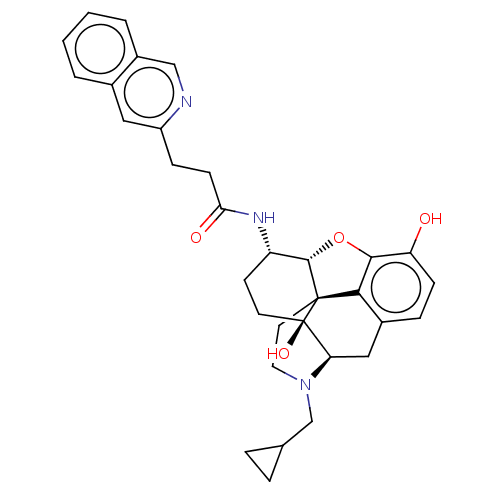

 Search and Browse
Search and Browse
 Download
Download
 Enter Data
Enter Data
| Target/Host (Institution) | Ligand | Target/Host Links | Ligand Links | Trg + Lig Links | Ki nM | ΔG° kJ/mole | IC50 nM | Kd nM | EC50/IC50 nM | koff s-1 | kon M-1s-1 | pH | Temp °C |
|---|---|---|---|---|---|---|---|---|---|---|---|---|---|
| Mu-type opioid receptor (MOUSE) | BDBM50066277 (CHEMBL2419119) | PDB Reactome pathway KEGG UniProtKB/SwissProt B.MOAD GoogleScholar AffyNet | CHEMBL PC cid PC sid UniChem Similars | Article PubMed | 0.680 | n/a | n/a | n/a | n/a | n/a | n/a | n/a | n/a |
Virginia Commonwealth University Curated by ChEMBL | Assay Description Displacement of [3H]naloxane from mouse MOR expressed in CHO cells after 1.5 hrs by [35S]GTPgammaS binding assay | Bioorg Med Chem 23: 1701-15 (2015) Article DOI: 10.1016/j.bmc.2015.02.055 BindingDB Entry DOI: 10.7270/Q2PK0HTN | |||||||||||
| More data for this Ligand-Target Pair | |||||||||||||
| Mu-type opioid receptor (MOUSE) | BDBM50066277 (CHEMBL2419119) | PDB Reactome pathway KEGG UniProtKB/SwissProt B.MOAD GoogleScholar AffyNet | CHEMBL PC cid PC sid UniChem Similars | Article PubMed | 0.680 | n/a | n/a | n/a | n/a | n/a | n/a | n/a | n/a |
Virginia Commonwealth University Curated by ChEMBL | Assay Description Displacement of [3H]-naloxone from mouse mu opioid receptor expressed in CHO cells after 1.5 hrs | Bioorg Med Chem Lett 23: 5045-8 (2013) Article DOI: 10.1016/j.bmcl.2013.07.043 BindingDB Entry DOI: 10.7270/Q2H41VC9 | |||||||||||
| More data for this Ligand-Target Pair | |||||||||||||
| Mu-type opioid receptor (MOUSE) | BDBM50066277 (CHEMBL2419119) | PDB Reactome pathway KEGG UniProtKB/SwissProt B.MOAD GoogleScholar AffyNet | CHEMBL PC cid PC sid UniChem Similars | Article PubMed | n/a | n/a | n/a | n/a | 1.10 | n/a | n/a | n/a | n/a |
Virginia Commonwealth University Curated by ChEMBL | Assay Description Agonist activity at mouse mu opioid receptor expressed in CHO cells assessed as stimulation of [35S]-GTPgammaS binding after 1.5 hrs | Bioorg Med Chem Lett 23: 5045-8 (2013) Article DOI: 10.1016/j.bmcl.2013.07.043 BindingDB Entry DOI: 10.7270/Q2H41VC9 | |||||||||||
| More data for this Ligand-Target Pair | |||||||||||||
| Mu-type opioid receptor (MOUSE) | BDBM50066277 (CHEMBL2419119) | PDB Reactome pathway KEGG UniProtKB/SwissProt B.MOAD GoogleScholar AffyNet | CHEMBL PC cid PC sid UniChem Similars | Article PubMed | n/a | n/a | n/a | n/a | 1.10 | n/a | n/a | n/a | n/a |
Virginia Commonwealth University Curated by ChEMBL | Assay Description Stimulation of mouse MOR expressed in CHO cells after 1.5 hrs by [35S]GTPgammaS binding assay | Bioorg Med Chem 23: 1701-15 (2015) Article DOI: 10.1016/j.bmc.2015.02.055 BindingDB Entry DOI: 10.7270/Q2PK0HTN | |||||||||||
| More data for this Ligand-Target Pair | |||||||||||||